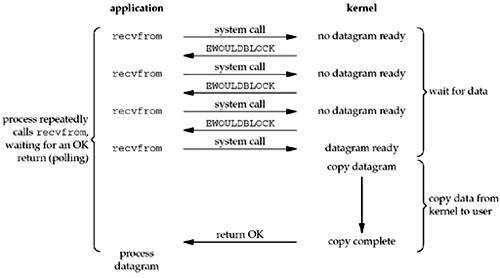IO通信模型同步非阻塞模式NIO(NonBlocking IO)
Posted niumoo
tags:
篇首语:本文由小常识网(cha138.com)小编为大家整理,主要介绍了IO通信模型同步非阻塞模式NIO(NonBlocking IO)相关的知识,希望对你有一定的参考价值。

同步非阻塞模式(NonBlocking IO)
在非阻塞模式中,发出Socket的accept()和read()操作时,如果内核中的数据还没有准备好,那么它并不会阻塞用户进程,而是立刻返回一个信息。也就是说进程发起一个read操作后,并不需要一直阻塞等待,而是马上就得到了一个结果。
如果结果发现数据准备完毕就可以读取数据,然后拷贝到用户内存。如果结果发现数据没有就绪也会返回,进程继续不断的主动询问数据的准备情况是非阻塞模式的一个特点。

伪代码表示如下:
{
while(read(socket, buffer) != SUCCESS){
}
process(buffer);
}Java同步非阻塞模式
如上所述,Java的Socket是阻塞模式的典型应用。在发起accpet()和read()请求之后会持续阻塞,但是Java中提供了setSoTimeout()方法设置超时时间,在固定时间内没有得到结果,就会结束本次阻塞,等待进行下一次的阻塞轮训。这是,也就实现了应用层面的非阻塞。
Java中Socket中的setSoTimeout()方法:
public synchronized void setSoTimeout(int timeout) throws SocketException {
if (isClosed())
throw new SocketException("Socket is closed");
if (timeout < 0)
throw new IllegalArgumentException("timeout can‘t be negative");
getImpl().setOption(SocketOptions.SO_TIMEOUT, new Integer(timeout));
}Java同步非阻塞模式编码
通过设置setSoTimeout()使阻塞模式的服务端accpet()和read()优化为非阻塞模式。
SocketServerNioListenAndRead.java
import org.slf4j.Logger;
import org.slf4j.LoggerFactory;
import java.io.IOException;
import java.io.InputStream;
import java.io.OutputStream;
import java.net.ServerSocket;
import java.net.Socket;
import java.net.SocketException;
import java.net.SocketTimeoutException;
/**
* <p>
* 非阻塞IO - 监听非阻塞 - 读取非阻塞
*
* @Author niujinpeng
* @Date 2018/10/15 14:53
*/
public class SocketServerNioListenAndRead {
/**
* 日志
*/
private static final Logger logger = LoggerFactory.getLogger(SocketServerNioListenAndRead.class);
private static Object xWait = new Object();
public static void main(String[] args) throws IOException {
ServerSocket serverSocket = null;
try {
serverSocket = new ServerSocket(83);
serverSocket.setSoTimeout(100);
while (true) {
Socket socket = null;
try {
socket = serverSocket.accept();
} catch (SocketTimeoutException e) {
synchronized (SocketServerNioListenAndRead.xWait) {
logger.info("没有从底层接收到任务数据报文,等待10ms,,模拟事件X的处理时间");
SocketServerNioListenAndRead.xWait.wait(10);
}
continue;
}
InputStream input = socket.getInputStream();
OutputStream output = socket.getOutputStream();
Integer sourcePort = socket.getPort();
int maxLen = 2048;
byte[] contentBytes = new byte[maxLen];
int realLen;
StringBuffer message = new StringBuffer();
// 接收消息非阻塞实现
socket.setSoTimeout(10);
BIORead:
while (true) {
try {
// 读取的时候,程序会阻塞,知道系统把网络传过来的数据准备完毕
while ((realLen = input.read(contentBytes, 0, maxLen)) != -1) {
message.append(new String(contentBytes, 0, realLen));
/**
* 如果收到over,表示传送完毕
*/
if (message.toString().endsWith("over")) {
break BIORead;
}
}
} catch (SocketTimeoutException e) {
//===========================================================
// 执行到这里,说明本次read没有接收到任何数据流
// 主线程在这里又可以做一些事情,记为Y
//===========================================================
logger.info("这次没有从底层接收到任务数据报文,等待10毫秒,模拟事件Y的处理时间");
continue;
}
}
// 输出信息
logger.info("服务器收到来自端口" + sourcePort + "的消息:" + message.toString());
// 响应
output.write("Done!".getBytes());
output.close();
input.close();
socket.close();
}
} catch (SocketException | InterruptedException e) {
logger.error(e.getMessage(), e);
} finally {
if (serverSocket != null) {
serverSocket.close();
}
}
}
}
上面的代码可以实现监听和读取数据的非阻塞,但是还是只能一个一个的处理,可以使用多线程稍微改进。
SocketServerNioListenThread.java
import org.slf4j.Logger;
import org.slf4j.LoggerFactory;
import java.io.InputStream;
import java.io.OutputStream;
import java.net.ServerSocket;
import java.net.Socket;
import java.net.SocketTimeoutException;
/**
* <p>
* 非阻塞IO - 监听非阻塞 - 读取非阻塞
* 通过加入线程的概念,让socket server能够在应用层面
* 通过非阻塞的方式同时处理多个socket套接字
* <p>
* 此时可以实现非阻塞的IO,但是因为调用了系统底层的阻塞同步IO,
* 因此仍然没有从根本上解决问题
*
* @Author niujinpeng
* @Date 2018/10/15 15:23
*/
public class SocketServerNioListenThread {
private static Object xWait = new Object();
private static final Logger LOGGER = LoggerFactory.getLogger(SocketServerNioListenThread.class);
public static void main(String[] args) throws Exception {
ServerSocket serverSocket = new ServerSocket(83);
serverSocket.setSoTimeout(100);
try {
while (true) {
Socket socket = null;
try {
socket = serverSocket.accept();
} catch (SocketTimeoutException e1) {
//===========================================================
// 执行到这里,说明本次accept没有接收到任何TCP连接
// 主线程在这里就可以做一些事情,记为X
//===========================================================
synchronized (SocketServerNioListenThread.xWait) {
LOGGER.info("这次没有从底层接收到任何TCP连接,等待10毫秒,模拟事件X的处理时间");
SocketServerNioListenThread.xWait.wait(10);
}
continue;
}
//当然业务处理过程可以交给一个线程(这里可以使用线程池),并且线程的创建是很耗资源的。
//最终改变不了.accept()只能一个一个接受socket连接的情况
SocketServerThread socketServerThread = new SocketServerThread(socket);
new Thread(socketServerThread).start();
}
} catch (Exception e) {
LOGGER.error(e.getMessage(), e);
} finally {
if (serverSocket != null) {
serverSocket.close();
}
}
}
}
/**
* 当然,接收到客户端的socket后,业务的处理过程可以交给一个线程来做。
* 但还是改变不了socket被一个一个的做accept()的情况。
*
* @author niujinpeng
*/
class SocketServerThread implements Runnable {
/**
* 日志
*/
private static final Logger LOGGER = LoggerFactory.getLogger(SocketServerThread.class);
private Socket socket;
public SocketServerThread(Socket socket) {
this.socket = socket;
}
@Override
public void run() {
InputStream in = null;
OutputStream out = null;
try {
in = socket.getInputStream();
out = socket.getOutputStream();
Integer sourcePort = socket.getPort();
int maxLen = 2048;
byte[] contextBytes = new byte[maxLen];
int realLen;
StringBuffer message = new StringBuffer();
//下面我们收取信息(设置成非阻塞方式,这样read信息的时候,又可以做一些其他事情)
this.socket.setSoTimeout(10);
BIORead:
while (true) {
try {
while ((realLen = in.read(contextBytes, 0, maxLen)) != -1) {
message.append(new String(contextBytes, 0, realLen));
/*
* 我们假设读取到“over”关键字,
* 表示客户端的所有信息在经过若干次传送后,完成
* */
if (message.indexOf("over") != -1) {
break BIORead;
}
}
} catch (SocketTimeoutException e2) {
//===========================================================
// 执行到这里,说明本次read没有接收到任何数据流
// 主线程在这里又可以做一些事情,记为Y
//===========================================================
LOGGER.info("这次没有从底层接收到任务数据报文,等待10毫秒,模拟事件Y的处理时间");
continue;
}
}
//下面打印信息
Long threadId = Thread.currentThread().getId();
LOGGER.info("服务器(线程:" + threadId + ")收到来自于端口:" + sourcePort + "的信息:" + message);
//下面开始发送信息
out.write("回发响应信息!".getBytes());
//关闭
out.close();
in.close();
this.socket.close();
} catch (Exception e) {
LOGGER.error(e.getMessage(), e);
}
}
}
同步非阻塞模式总结
用户需要不断地调用,尝试读取数据,直到读取成功后,才继续处理接收的数据。整个IO请求的过程中,虽然用户线程每次发起IO请求后可以立即返回,但是为了等到数据,仍需要不断地轮询、重复请求,消耗了大量的CPU的资源。一般很少直接使用这种模型,而是在其他IO模型中使用非阻塞IO这一特性。
开发难度相对于阻塞IO模式较难,适合并发小且不需要及时响应的网络应用开发。
本文原发于个人博客:https://www.codingme.net 转载请注明出处
GitHub 源码:https://github.com/niumoo/java-toolbox/
此文参考文章:IO复用,AIO,BIO,NIO,同步,异步,阻塞和非阻塞
此文参考文章:6.2 I/O Models

以上是关于IO通信模型同步非阻塞模式NIO(NonBlocking IO)的主要内容,如果未能解决你的问题,请参考以下文章